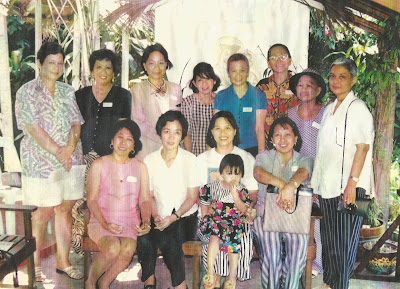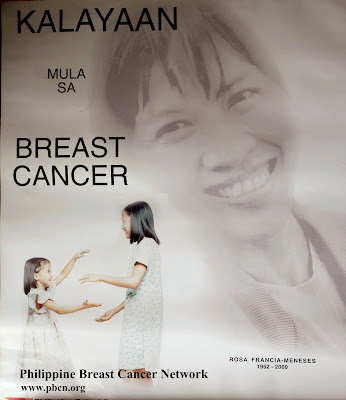Today, the 23rd day of September 2023 marks 23 years since Rosa was given her wings to fly. Before her death, the Canadian Breast Cancer Network published in their Network News Vol.5 No.1 Fall 2000, the following article which I have edited.
“My story is the same as every woman with breast
cancer,” Rosa declared during the opening day plenary of the Second World
Conference on Breast Cancer in Ottawa in 1999.
Indeed, all women with breast cancer are similarly
challenged and have no choice but to accept their diagnosis. But in time, each
woman finds her rightful place in the battlefield of breast cancer where there
are a few chosen to fight for others. The swiftness of events in the life of a
woman with breast cancer can deliver her from the rapids of the unknown to the
rivers of immortality. She must raise her head and look far beyond.
Had Rosa undergone a mastectomy years before the First World Conference on Breast Cancer in Kingston, Ontario in 1997, or after that historical event, the Philippine Breast Cancer Network (PBCN) would never have been. But as destiny had it, Rosa lost her breast without her informed consent on February 10th 1997, and was given a very poor survival prognosis just five months before – long enough to heal her blasted chest yet close enough to defer chemotherapy and radiation.
I had worked a total of ten years for an American pharmaceutical and American insurance company before engaging in organic farming and environmental waste management nationwide when breast cancer violated my family. I felt like I had been stabbed in my back but later realized that because of my entire background, I was able to absorb and rapidly internalize the intricacies surrounding the disease. I was thus tailored made to wage battle alongside my wife.
Twenty-seven years ago, Rosa and I fought another
battle. It was during those fearful days of Martial Law when the dictator
Marcos unleashed his dogs of war where thousands of students, farmers and
workers lost their lives, that our future was sealed. Rosa and I met in the
underground movement and together went deeper into the arena of armed struggle.
We were always in constant danger of arrest, or at worst, summary execution
when caught.
On several occasions, I witnessed the courage and
steadfastness of my amazon warrior: when she kept her presence of mind and
calmly lost military agents trailing her; when she bravely searched for me in
enemy territory when I failed to make contact; when she delivered our first born
in the guerrilla zone without medical attention; and when she confidently faced
an arresting team at the doorstep and bluffed her way from capture. We were
only twenty-two years old then, but we were able to survive those precarious
years.
Two weeks before the violence of breast cancer, our eight-year-old daughter became the victim of a severe drug overdose from a
pediatrician’s prescription. I was raising hell with the Philippine Medical
Association and the Philippine College of Pediatrics when Rosa’s nightmare
became priority.
Then during Rosa’s confinement, while on the way
home from the hospital, our Volkswagen Beetle was hit from behind by a
ten-wheeler truck. Had it not been a beetle where the engine was at the back, I
couldn’t imagine what would have happened to all our four children on board. At
that point in time, I was already asking whether my entire family was to be
wiped out right in front of me. Miraculously, only minor injuries were
sustained.
Our youngest child had just turned two, so when
Rosa was given not more than two years to survive, she could not accept the
prognosis. She had to fight back. She would simply not allow herself to become
another number in medical records or a clinical statistic. We had together
stared more than once at the face of death in our youth and we were once again
being called to engage in another serious battle. It was our total ignorance on
the matter that scared us, and worse, there was no one to gather immediate
information from – except the doctors. Our gut sense told us they were not a
reliable source and we had to truly know the enemy ourselves.
A year later, Rosa convened the first ever Philippine Conference on Breast Cancer which saw the attendance of Andrea Martin and Kimiko Goldberg and numerous breast cancer victims. Another year later in 1999, Rosa was selected as a plenary speaker at the Brussels World Conference on Breast Cancer Advocacy. A few months later, she was invited to be an opening day plenary speaker at the Ottawa World Conference on Breast Cancer. Her story by now, had become known to the entire world.
Barely two months upon returning, Rosa convened the 2nd Philippine Conference on Breast Cancer. By this time, the ranks of the PBCN had ballooned to more than 400 nationwide. Several symposiums, lectures and activities on breast cancer and the environment were held. The PBCN’s newsletter was periodically circulated and became a very reliable and truthful source for public information. So many patients called, written and visited our home-turned-breast cancer center, seeking information and treatment. Between Rosa and I were also numerous interviews on national television, radio, newspapers and magazines. The landscape of breast cancer had drastically changed in the Philippines, that the Department of Health, the medical profession and the pharmaceutical industry can no longer ignore the challenge from the PBCN.
Rosa believed strongly in the dignity and honor of
women, especially those faced with breast cancer. From the very start, Rosa
planned for the PBCN to be of the highest esteem, so that breast cancer victims
would be proud to be part of the PBCN. In so doing, the PBCN has been very
selective in raising funds, never asking money from polluting and cancer-causing companies, and never having women with breast cancer beg for their
lives!
In her fourth year of battle, Rosa continued with
non-toxic and non-invasive regimens, refusing several offers of chemo and
radiation from doctors, hospitals and pharmaceuticals. Her last crisis though
had become the most serious. Her lungs had been invaded by cancer and she
needed to undergo pleurodesis in preparation for her next challenge.
Rosa’s body was now being completely surrounded by enemy cancer cells. She was already experiencing battle fatigue, but she would not raise the white flag. Even going to the toilet, she would inch her way with assistance. Rosa would not surrender as we hoped and prayed that a thunderstorm would suddenly come and send all the enemy cancer cell scampering away.
The irony of breast cancer is its own tragedy.
While thousands of lives will be lost at the onset of battle, even the most
gallant and fearless of breast cancer warriors will not be spared. Rosa was out
to engage the enemy and in battle, death is a common occurrence. Breast cancer
is a war without prisoners. However, when one’s life is offered for the greater
good, then death is just another journey and not an end. It is the tragedy of
death that will usher in life.
Just one rose that could leave a man spell-bound,
just one scent can give passion to life. Just one rose whose beauty and splendor, the ugliness of breast cancer cannot hide. This is the legacy that
Rosa left behind.
























